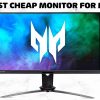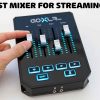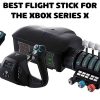A dual-monitor setup (or more) is often required for an effective streaming battlestation.
This will consist of a primary monitor, used solely for gameplay. As well as a second monitor for managing background tasks e.g. the chat, alerts, and other apps/ software, etc.
Therefore, to cover the best monitors for streaming, we will take a look at the six best displays that “top-streamers” currently use as their primary gaming monitor, along with a selection of cheap secondary monitors that you can pair with it.
This method aims to save you some dollars, as high-specs on both monitors won’t be necessary.
Contents:
1. What primary monitors do top-streamers use?
2. What is the best second monitor for streaming?
What monitors do streamers use?
6. HP Omen X 25” Gaming Monitor
The Omen X is a Full HD, 24.5-inch monitor with Nvidia G-Sync. Recognized at the official Overwatch display, it brings forward the highest possible specs to meet the utmost demands of gamers. We’re talking about a lightning-fast 240Hz refresh rate and a 1ms response time.
The result is virtually no ghosting and impeccably fast gameplay. A reduction in lag allows for swift movements so nothing can get in your way. This is essential for streamers who are after a monitor that won’t hold them back when it’s time to impress for their audience.
To achieve such impressive performance, the Omen X utilizes Nvidia G-Sync technology. Essentially, this synchronizes the displays refresh rates to the GPU in your GeForce RTXTM-powered PC. In turn, scenes will appear in an instant to give you a serious competitive edge.
For lighting, the display can produce 400 nits of brightness and an RGB spectrum of 16.8 million colors. Using the Picture Mode, it’s possible to tweak the display from warm to cool colors. Choosing the monitor’s ambient light will help prevent eye-strain during the longest of streaming sessions.
We particularly like that the design features a micro-edge bezel around the rim of the screen and a diamond-shaped steel base. Both of these elements aim to maximize the potential of space, making it ideal for tightly packed multiple monitor setups. Defran currently uses the OMEN X25.
Prices pulled from the Amazon Product Advertising API on:
Product prices and availability are accurate as of the date/time indicated and are subject to change. Any price and availability information displayed on [relevant Amazon Site(s), as applicable] at the time of purchase will apply to the purchase of this product.
5. ASUS TUF VG259QM 24.5”
The TUF Gaming VG259QM is a 24.5-inch Full HD (1920 x 1080) IPS, HDMI monitor. Designed for professional gamers and immersive gameplay, it has an out of the box 240hz refresh rate. By viewing the settings of the monitor, you then have six options to overclock this to a whopping 280hz.
For sharp gaming visuals with high frame rates, the IPS technology enables a lighting fast response. At 280Hz and 80 overdrive, it measures just 1.7ms. Whereas 240Hz @ 60 OD is closer to 1ms. As a result, it offers one of the best response times/ input lag out of all of the newer IPS monitors.
To eliminate ghosting/ tearing for high frame rates, the monitor enables ELMB together with G-SYNC Compatibility. The ELMB function is surprisingly good and produces a buttery smooth image. How this works is by turning off the backlight between refreshes to reduce eye tracking motion blur.
Despite falling short on most other monitor displays, the HDR mode is another feature that can’t be ignored. Capable of 400 cd/m2, the display meets the stringent requirements for DisplayHDR™ 400 certification, resulting in a wider color range and higher contrast.
If you’re anything like xChocoBars, you will be very pleased with this monitor for all things gaming, streaming, video, and general web browsing. It’s on par with some of the best monitors that are twice its price point.
Prices pulled from the Amazon Product Advertising API on:
Product prices and availability are accurate as of the date/time indicated and are subject to change. Any price and availability information displayed on [relevant Amazon Site(s), as applicable] at the time of purchase will apply to the purchase of this product.
4. LG 27GN750-B 27
The LG 27GN750-B is a 240Hz monitor taken from the UltraGear lineup. It has a 1080p, IPS panel with native G-Sync and FreeSync support. The ultra-wide, 27-inch display can reduce screen tearing and minimize stutter for a smoother, faster gaming experience.
A noticeable area where the 27GN750-B excels is in its Nano IPS display. An extended color gamut of 99% of the sRGB results in even greater color-accuracy than other IPS displays. This enables it to deliver more vivid and lifelike colors that are crucial for the battlefield.
IPS panels weren’t always known for their responsiveness, however, this is not an issue with this monitor. It offers a super-fast 1ms response time to make dimming and flickering screens a thing of the past. When paired with the 240Hz refresh rate, expect almost surreal visual fluidity.
To support the screen itself, the 27GN750-B features a sleek V-shape stand that rests steady and resists shaking. The height-adjustable stand can pivot and tilt in three dimensions. It’s also possible to rotate the screen 180 degrees for a vertical viewing angle.
Input and outputs on the back include two HDMI’s, one DisplayPort, and three USB 3.0’s. TimTheTatman swears by this monitor for his live streaming sessions.
Prices pulled from the Amazon Product Advertising API on:
Product prices and availability are accurate as of the date/time indicated and are subject to change. Any price and availability information displayed on [relevant Amazon Site(s), as applicable] at the time of purchase will apply to the purchase of this product.
3. Acer Predator XB273
The Acer Predator XB273 is a full HD monitor that shines in performance, color, and speed. It has a large 27” IPS panel that supports a blazing-fast 240Hz refresh rate. To eliminate screen tearing and produce buttery smooth gameplay, the display utilizes a native G-sync chip.
One big advantage of the G-Sync module is having “variable overdrive”. VO issues the fastest response times relative to what refresh rate you are in – therefore allowing for greater results at low frame rates. As a result, there’s minimal ghosting or overshoot as the refresh rate changes.
To make the most of the IPS panel technology, the XB273 provides several useful features. Most noticeably, it’s possible to fine-tune your visuals on the fly so you can have vibrant colors in console games. Moreover, the “Dark Boost” mode delivers enhanced clarity even in dimly lit environments.
Any streamer who’s at their computer all day will understand why eye-strain is such of a concern. To reduce fatigue over long streaming sessions, the monitor offers a variety of different eye-protect settings. These include Flicker-less, Blue-light Filter, Comfy view, and Low dimming.
In terms of appearance, the XB273 comes at you with a zero-frame design and a sleek, ergonomic stand. The stand can swivel, tilt, and raise in height for the ideal viewing position. Furthermore, a click release hatch lets you separate it from the monitor so it can be Vesa mounted to the wall.
Summit1g is a big fan of Acer Predator monitors.
Prices pulled from the Amazon Product Advertising API on:
Product prices and availability are accurate as of the date/time indicated and are subject to change. Any price and availability information displayed on [relevant Amazon Site(s), as applicable] at the time of purchase will apply to the purchase of this product.
2. BenQ Zowie XL2746S
The BenQ Zowie XL2746S is a full-HD, 240 Hz gaming monitor that delivers exceptional motion handling. Fine-tuned to guarantee the clearest images for fast-pace FPS action, it has a 24.5” (TN) display with a rapid 0.5-millisecond response time.
One noticeable feature of the L2746S is its newly introduced DyAc⁺ technology. DyAc⁺ assists with vigorous in-game actions (such as recoil) by making spraying appear less blurry. This process works through “electron beam tracking”, which is when the backlight is switched off at a fixed point.
Due to providing different benefits and processing at a variable refresh rate, it’s worth noting that DyAc+ is not compatible with G-sync/ Free Sync. Instead, DyAc+ provides a clearer dynamic vision based on an already high and stable refresh rate and FPS.
Another prominent feature of this monitor is the iconic “shield” design that allows you to block out nearby light and foes. When coupled with the “Black eQualizer” that increases the exposure in dark scenes, your visibility and focus on the game should see a dramatic improvement.
For the build, the stand uses a smaller base than the previous model. The new design manages to save space while maintaining the same stability. This is particularly useful as it means users can get their peripherals right up next to the base, to make movements more comfortably.
Just like DrDisrespect and Tfue, anyone streaming FPS games will dominate on this next-level monitor.
Prices pulled from the Amazon Product Advertising API on:
Product prices and availability are accurate as of the date/time indicated and are subject to change. Any price and availability information displayed on [relevant Amazon Site(s), as applicable] at the time of purchase will apply to the purchase of this product.
1. Alienware 25 AW2521HF
The Alienware AW2521HF is a premium 24.5”, 240Hz gaming monitor that offers style along with performance. Designed for elite-level tournament action, it is currently the official monitor used by Team Liquid and can be found at the League of Legends global esports events.
In highly competitive games, the refresh rate can make a huge difference and the AW2518HF clocks in at under a 1ms response. To eliminate screen tearing, the Nvidia G-Sync™ technology transmits information much faster than other leading displays, resulting in a smoother-looking motion.
Image clarity is especially important for any top-level monitor, being just another area where the AW2518HF excels. The fast IPS technology helps maintain intensity from every angle of the screen, while the native Full-HD resolution provides the best pixel per-inch-ratio.
To support the display, the iconic Alienware stand forms a rock-solid base. It lets you pivot and tilt the screen in any direction making it easy to find your ideal viewing position. Moreover, the tapered legs allow you to turn your keyboard in at an angle so you can play the way you like.
Overall, it’s the perfect choice for any e-sport enthusiast looking to elevate their game. Nickmercs, Ninja, and Shroud all love their Alienware monitors!
Prices pulled from the Amazon Product Advertising API on:
Product prices and availability are accurate as of the date/time indicated and are subject to change. Any price and availability information displayed on [relevant Amazon Site(s), as applicable] at the time of purchase will apply to the purchase of this product.
What is the best second monitor for streaming?
6. Samsung 24″ FHD
Pannel: TN
Response time: 5ms
Vesa Mount: ✓
Samsungs monitors have never really had the same reputation as their HD TVs, though that’s changed in recent years. Affordable, substantial in size (24 inches diagonal), and with built-in AMD FreeSync technology, makes it a fantastic choice for a variety of different settings.
The panel is a TN panel (not IPS), which means you’re going to be able to expect a little bit faster refresh rates – 75 Hz versus 60 Hz that are common with IPS setups. This allows for smoother motion and a more fluid picture, especially when you are playing graphically demanding games.
Built-in FreeSync technology from AMD keeps you rocking and rolling with next to no image tear or ghosting whatsoever. It works particularly well when you are streaming games but won’t hold you back if you are using it for a dual monitor system, too.
Prices pulled from the Amazon Product Advertising API on:
Product prices and availability are accurate as of the date/time indicated and are subject to change. Any price and availability information displayed on [relevant Amazon Site(s), as applicable] at the time of purchase will apply to the purchase of this product.
5. Dell SE2419HR – 24 Inch
Pannel: IPS
Response time: 5ms
Vesa Mount: X
The folks at Dell have been responsible for making some of the very best monitors ever, and this is just another to their collection. The look and feel is slick and modern, the materials used are high-end, and it gives the impression that it’s more expensive than it actually is.
Users are going to appreciate this monitor, especially if they need a second display for their stream chat. The colors are rich and accurate, the contrast is fantastic when compared to a lot of the other options out there, and the 16:9 aspect ratio allows for “double duty” as a gaming monitor.
This panel also takes full advantage of AMD Radeon FreeSync technology. Of course, Nvidia cards can run well with this panel too, but if you have AMD graphics cards “under the hood” of your setup, this monitor is really going to shine.
Prices pulled from the Amazon Product Advertising API on:
Product prices and availability are accurate as of the date/time indicated and are subject to change. Any price and availability information displayed on [relevant Amazon Site(s), as applicable] at the time of purchase will apply to the purchase of this product.
4. ASUS VA24EHE 23.8”
Pannel: IPS
Response time: 5ms
Vesa Mount: ✓
This ASUS Full HD, IPS monitor comes with a respectable 75Hz refresh rate; slightly faster than a traditional 60Hz monitor. The 21.5-inch display utilizes AMD “FreeSync” technology to eliminate screen tearing and produce a smoother gaming experience.
Besides selling at a very reasonable price, the strikingly thin aesthetics of this monitor is just another aspect that makes it so popular. At only 0.24-inches, the elegant bezel blends into a “zero-edge” frame design. Because of this, it reduces extra bulk and provides a modern touch to any home.
Other features include multiple inputs (HDMI & VGA), and a simple but effective chassis. The hinge mechanism on the base of the stand is not the most sophisticated, but it does allow for a backward tilt of approximately 20 degrees. All in all, it’s a small yet effective second monitor for streaming.
Prices pulled from the Amazon Product Advertising API on:
Product prices and availability are accurate as of the date/time indicated and are subject to change. Any price and availability information displayed on [relevant Amazon Site(s), as applicable] at the time of purchase will apply to the purchase of this product.
3. Sceptre E248W-19203R 24″
Pannel: TN
Response time: 5ms
Vesa Mount: ✓
Sceptre has a reputation for making top-tier gaming hardware at entry-level price points, and this 24” monitor is no exception. Slim, sleek, and with a minimalist design that looks great on any desk, the engineering of this product allows the screen to be the star of the show.
With full native support for 1920 x 1080 (Full HD), it’s more than capable of handling all those nitty-gritty background tasks. Add next to zero input latency, 75 Hz refresh rates, and a contrast ratio that gets north of 1000:1 into the mix, and you might even want to play some games on it too.
Besides this, what’s great about the E248W is the ability to plug in pretty much any input source. It has two built-in HDMI ports, a VGA port, and includes an HDMI to DVI cable. Furthermore, with the addition of a Vesa mount, it would make an ideal vertical monitor for managing your stream chat.
Prices pulled from the Amazon Product Advertising API on:
Product prices and availability are accurate as of the date/time indicated and are subject to change. Any price and availability information displayed on [relevant Amazon Site(s), as applicable] at the time of purchase will apply to the purchase of this product.
2. BenQ GL2480 24″ IPS
Pannel: IPS
Response time: 2ms
Vesa Mount: ✓
This BenQ 24 inch, IPS monitor has incredible colors and a vibrancy that is tough to beat, even if it is at a lower price point. The 1080p FHD resolution is crisp and accurate, with the IPS panel technology handling the bulk of the heavy lifting from a graphics render standpoint.
A super-slim edge to edge bezel makes the screen appear a little bit larger while retaining an attractive, minimalist look. To help keep your desk clean and clutter-free, the design of the integrated cable management system is especially clever and runs through the back of the stand.
The BenQ has a super quick 1 ms response time, and a 75 Hz refresh rate to help you compete online even in the most demanding of circumstances – like competitive online shooters, for example. In short, at under $120, it’s a cheap and cheerful secondary monitor for either gaming or streaming.
Prices pulled from the Amazon Product Advertising API on:
Product prices and availability are accurate as of the date/time indicated and are subject to change. Any price and availability information displayed on [relevant Amazon Site(s), as applicable] at the time of purchase will apply to the purchase of this product.
1. Acer SB240Y 23.8” Full HD
Pannel: IPS
Response time: 1ms
Vesa Mount: X
If you are running an AMD Radeon graphics card, then you have to take a closer look at this specific Acer IPS monitor. Designed and engineered to take full advantage of AMD FreeSync technology, you’ll be able to unleash the full capabilities of your graphics card thanks to this hardware matchup.
Of course, this gaming monitor will work well with Nvidia cards too (you just get a bump in performance with AMD hardware). We’re still talking about a 1080p FHD gaming monitor here, an IPS monitor that has beautiful colors, rich vibrancy, and a blazing fast 120 Hz refresh rate.
Combine all of that with 1ms of input latency, a “zero frame” panel, and one of the best industrial designs we’ve ever seen from a display and this becomes a bit of a no-brainer option. There’s just a lot to love with this Acer set up. It’s currently one of the best second monitors around.
Prices pulled from the Amazon Product Advertising API on:
Product prices and availability are accurate as of the date/time indicated and are subject to change. Any price and availability information displayed on [relevant Amazon Site(s), as applicable] at the time of purchase will apply to the purchase of this product.
What Monitor Do I Need for Streaming?
Monitors are a dime a dozen and you can get one for just about any particular focus that you want. However, when it comes to gaming and streaming, you want one that has at least a Full-HD (1080p) resolution and the lowest response time possible.
Moreover, for the best streaming experience, you want monitors with G-Sync tech from Nvidia or AMD Freesync. The resolution, frame rate, and response time are the most critical factors to consider. If you want something in 4k or even 8k resolution, the odds are that all of the rest will fall neatly into line.
Nvidia’s G-Sync technology and AMD’s competing Free Sync technology are true game-changers in the industry. Both of these technologies automatically synchronize the frame rates of the monitor with your GPU, which means that it eliminates tearing during gameplay.
If you’re streaming with Twitch, the last thing that you want your viewers to see is a fast-paced game that is experiencing a ton of tearing and other frame rate issues.
Fortunately, AMD and Nvidia have solved that problem, and it’s one of the most important features to look for in a new streaming monitor. A 144Hz refresh rate is the most popular and with G-sync or Free Sync, you’ll get every bit of it, even if you want to go even higher.
How to Choose the Best Monitor for Streaming
Now that you’ve resolved the three “necessary” features with resolution, refresh rate, and response time, the rest is entirely personal. Standard formats are in 16:9; however, some streamers like to stretch that out even more, so it’s a matter of personal preference.
Refresh Rate
The refresh rate of a monitor is defined by how many times the onscreen image is updated within a specified period of time, typically far faster than you can blink your eyes, as its measured in milliseconds.
The refresh rates that you want are going to be determined by the capability of your CPU and GPU. You don’t want to purchase something that is above and beyond your gaming rig. If your GPU can only push 30fps, you’re wasting your time with a 144Hz refresh rate.
Display Size/ Resolution
Typically, higher resolutions are tied to refresh rates. For instance, if you want a monitor with a resolution of 2560×1440, you’re probably looking at an optimal refresh rate of 240 Hz, which means that you need the minimum specs of a Geforce RTX 3080 with an Intel i9-11900k.
As resolution changes, the corresponding refresh rates that the monitor is capable of change too.
Response Time
Response time is less a response to input and more a measured time between one color changing to another color. Latency is an issue as well and if you want the best monitor for streaming, you want a response time that is equal to or lower than 5ms.
Image Quality
This is aesthetic and nothing more, however, if you’re aiming for outstanding refresh rates, auto-syncing features, and superior response times, your image quality is going to be 4k or higher and at a minimum of 400 nits brightness.
Inputs and Outputs
You want multiple HDMI inputs if possible, with USB-C 3.0, a Display Port, and Headphone jacks. All of these inputs are essential and the more of each one that is available, the better.
Final Thoughts
It’s quite a lot when you add it all together; however, you don’t need premium everything to successfully Twitch stream with a quality experience for all. Go with what your gaming setup allows and maximize its use.
Frequently asked questions
Do you need a good monitor for streaming?
Your monitor will not affect the quality of the stream, it will only affect what you see. However, gaming/ streaming on a monitor with greater refresh rates and response times will enable you to react faster, giving you the competitive edge for your audience.
Do you need dual monitors to stream?
A second monitor is necessary for streaming because it allows you to perform background tasks while gaming solely on the first display. These tasks include managing the chat, alerts, OBS, and other apps/ software. The second monitor won’t be visible to your audience.
Why do streamers use 3 monitors?
A triple monitor setup provides an even larger area to perform background tasks on. For example, if your first monitor is solely for gameplay, the second monitor could be dedicated to everything stream related, and the third for other software and apps.
How do I stream on two monitors?
Connect two monitors to your PC via HDMI. Next, right-click on your desktop background and click on Display settings. Then, click on multiple displays, and select extend these displays. You will then be able to drag windows to your secondary monitor.
We hope you found this post useful on the top monitors for streaming!
Click here for a list of Streaming Essentials to get you started on Twitch!
Click here for the 12 Best Cheap Streaming PC’s!












